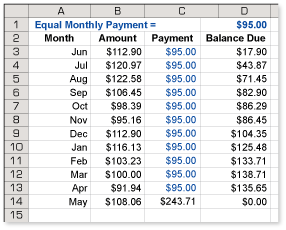-
Rules set language apart from simpler forms of communication. These rules help the reader or listener understand the writer or speaker. In natural languages, like English or Spanish, these rules are called syntax. In mathematics, these rules are called order of operations. Think about the following sentence.
My friends and I are going to dinner and a movie later.
How many ways can this sentence be understood? What common rules help us to understand what the writer probably means? In the same way, it is important to understand what the expression

actually means. Try calculating by multiplying first and then by adding first. Are the answers the same? Can you see why order of operations is important in creating meaning?
-
Visit Lower Electric Bill Today for tips on saving electricity. Also learn how to pay less for electric by switching your electric supplier.
Ever wonder what all the different charges are on your electric bill? Learn how to decipher your electric bill to better understand your service.
-
Add the 12 monthly usage amounts and subtract the 11 equal payments already made to find the amount you owe in May.

You owe $243.71 in May.
Here is another way to find this solution. For each month, subtract the payment you made from the amount you owe. Then use a spreadsheet to find the balance due in May.
Download the spreadsheet and try entering different amounts as your equal monthly payment. Try finding an amount so that you owe nothing in May.
Which would you prefer? (a) Make lower monthly payments and owe a lot in May. (b) Make payments that are just the right amount and owe nothing in May. (c) Make higher monthly payments and end up with a credit in May.
-
Comments (12)
These comments are not screened before publication. Constructive debate about the information on this page is welcome, but personal attacks are not. Please do not post comments that are commercial in nature or that violate copyright. Comments that we regard as obscene, defamatory, or intended to incite violence will be removed. If you find a comment offensive, you may flag it.
When posting a comment, you agree to our Terms of Use.Showing 12 commentsSubscribe by email Subscribe by RSSGuest 2 years ago |JYNAY0 0Minda Morton 5 years ago |The pacing guide for the first section of Chapter One sets aside a couple of days for a Project. Is that described anywhere, or is it up to the teacher to develop a project?2 0Jackie (moderator)1 decade ago |We have updated the link for the Consumer Suggestion on this page. Thank you again for notifying us of the broken link.0 0Ron Larson (author)1 decade ago |Thanks for pointing out the link that is no longer active. We will find a new link.0 0Guest 1 decade ago |The link to the sample electric bill takes me to a page not found error (error 404)0 0Ron Larson (author)1 decade ago |For whoever is testing the comment feature, "yes, it really is that simple". You don't need to log in to leave a comment as a guest. If you want to be identified, then you can register (at no charge) and then after logging in, viewers can see who is writing the comment. We don't require any personal information from you if you would like to remain anonymous.0 0Guest 1 decade ago |test0 0Ron Larson (author)1 decade ago |Thanks for the compliment. The book doesn't start on page 2. It opens to whatever page was most popular during the past 24 hours. This is a little bit like Wikipedia ...1 1Guest 1 decade ago |You can get to the table of contents by clicking on the "TOC & Index" icon at the top of the page.0 0Guest 1 decade ago |Book looks nice...uh, why does it start on page 2?2 1Guest 1 decade ago |Where's the table of contents?1 0Ron Larson (author)1 decade ago |Welcome to "Math & You." I started planning this book a year ago. We plan to have all 10 chapters available on the Internet around November 1, 2011. A print version will be available around the same time.2 0







